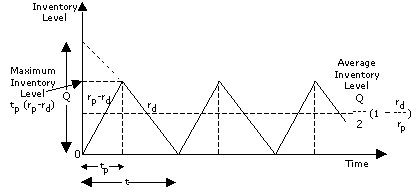EOQ With Uniform Replenishment
In the previous models, we assumed that the replenishment time is zero, i.e., the entire order was received just as inventory ran out of stock.
However, in real life situations, the production run may take a significant time to complete.

| Q* = | (2DCo) ---------- Ch |
rp --------- (rp - rd) |
||||||
| N* = | DCh (rp - rd) ---------------- 2Corp |
|||||||
| tp* = | 2DCo ---------------- 2Chrp (rp - rd) |
|||||||
| TC* = | 2DCoCh | 1 - | rd ---- rp |
Where:
rp = production rate in units per time period
rd = demand rate in units per time period
tp = length of production run
 Example: EOQ With Uniform Replenishment
Example: EOQ With Uniform Replenishment
The Long Ride Tyre Company produces 600 tyres per day and sells them at approximately half that rate. Accounting figures show that the production set-up cost is Rs. 500 and carrying cost per unit is Rs. 2.5. If annual demand is 60000 tyres, what is the optimal lot size and how many production runs should be scheduled per year?
Solution.
Given
Annual demand (D) = 60000 tyres
Carrying cost (Ch) = Rs. 2.5
Setup cost (Cs) = Rs. 500
Production rate (rp) = 600 tyres
Demand rate (rd) = 300 tyres
| Q* = | (2 X 60000 X 500 X 600) ----------------------------- 2.50 X (600 - 300) |
|
| = 6929 tyres. | ||
| N* = | 60000 -------- 6929 |
|
| = 8.65 runs/year or 9 runs/year (approx.) | ||



